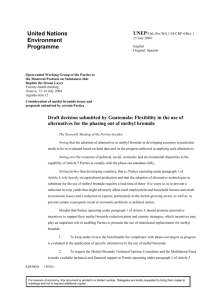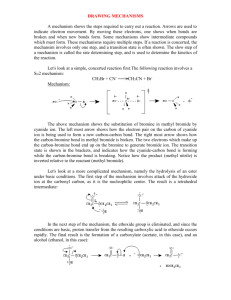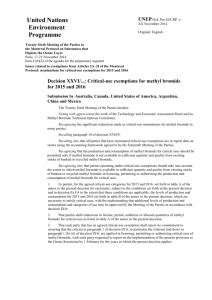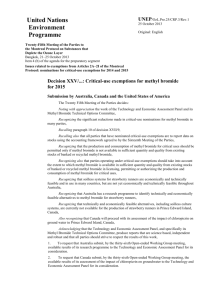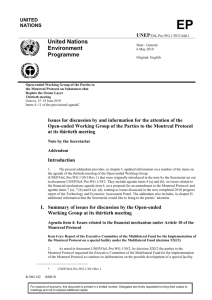E - Ozone Secretariat
advertisement
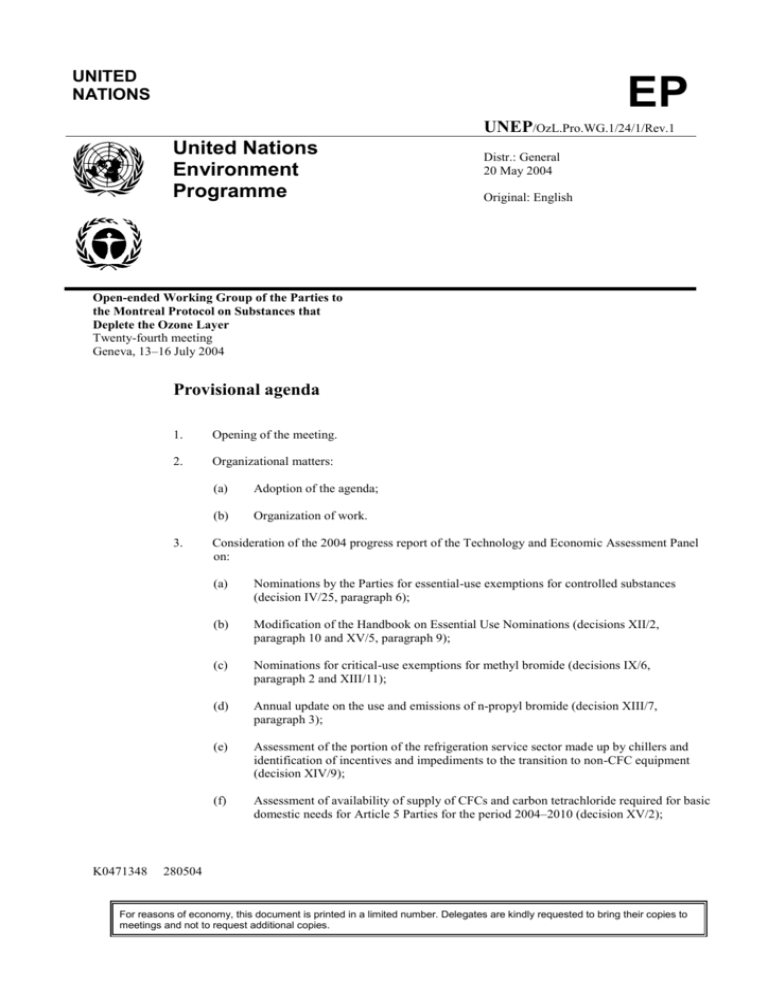
UNITED NATIONS EP UNEP/OzL.Pro.WG.1/24/1/Rev.1 United Nations Environment Programme Distr.: General 20 May 2004 Original: English Open-ended Working Group of the Parties to the Montreal Protocol on Substances that Deplete the Ozone Layer Twenty-fourth meeting Geneva, 13–16 July 2004 Provisional agenda 1. Opening of the meeting. 2. Organizational matters: 3. K0471348 (a) Adoption of the agenda; (b) Organization of work. Consideration of the 2004 progress report of the Technology and Economic Assessment Panel on: (a) Nominations by the Parties for essential-use exemptions for controlled substances (decision IV/25, paragraph 6); (b) Modification of the Handbook on Essential Use Nominations (decisions XII/2, paragraph 10 and XV/5, paragraph 9); (c) Nominations for critical-use exemptions for methyl bromide (decisions IX/6, paragraph 2 and XIII/11); (d) Annual update on the use and emissions of n-propyl bromide (decision XIII/7, paragraph 3); (e) Assessment of the portion of the refrigeration service sector made up by chillers and identification of incentives and impediments to the transition to non-CFC equipment (decision XIV/9); (f) Assessment of availability of supply of CFCs and carbon tetrachloride required for basic domestic needs for Article 5 Parties for the period 2004–2010 (decision XV/2); 280504 For reasons of economy, this document is printed in a limited number. Delegates are kindly requested to bring their copies to meetings and not to request additional copies. UNEP/OzL.Pro.WG.1/24/1/Rev.1 2 (g) Potential impacts of the phase-out of CFCs in Parties not operating under paragraph 1 of Article 5 on the availability of affordable inhaled therapy in Parties operating under paragraph 1 of Article 5 (decision XV/5, paragraph 7); (h) Review of requests for consideration of specific uses against decision X/14 criteria for process agents (decision XV/7, paragraph 3); (i) Assessment of the development and availability of laboratory and analytical procedures that can be performed without using the controlled substances in Annex A, B and C (Group II and III substances) of the Protocol (decision XV/8, paragraph 2); (j) Assessment of the volume of methyl bromide to be replaced by the implementation of technically and economically feasible alternatives to its quarantine and pre-shipment uses (decision XI/13, subparagraph 4 (b)); (k) Development of a timely plan of action to enable consideration of the possibility that modifying the regulatory requirements that mandate the use of halons on new airframes may be feasible without compromising the health and safety of airline passengers (decision XV/11); (l) Other issues arising out of the 2004 TEAP progress report. 4. Progress report by the Chair of the Steering Panel on the Evaluation and Review of the Financial Mechanism of the Montreal Protocol (decision XV/47). 5. The need for a study on the 20062008 replenishment of the Multilateral Fund for the Implementation of the Montreal Protocol (see decisions XIII/1and XIII/2). 6. Consideration of the terms of reference of the Executive Committee of the Multilateral Fund for an amendment of paragraph 10 (k) relating to the nomination and appointment of the Chief Officer of the Multilateral Fund Secretariat (decision XV/48). 7. Consideration of the implementation and operation of decision XV/3 on obligations of Parties to the Beijing Amendment under Article 4 of the Montreal Protocol with respect to hydrochlorofluorocarbons. 8. Consideration of reports on monitoring of trade in ozone-depleting substances and preventing illegal trade in ozone-depleting substances (decision XIV/7). 9. Update on the consideration of the use of the United Nations Globally Harmonized System for the Classification and Labelling of Chemicals for substances that deplete the ozone layer (decision XIV/8 (b) and paragraph 124 of the report of the Fifteenth Meeting of the Parties (UNEP/OzL.Pro.15/9)); 10. Report on the response to the arrangement under paragraph 2 of decision XV/15 for earlier reporting of consumption and production data and on its beneficial effect on the work of the Implementation Committee. 11. Issues arising from the Extraordinary Meeting of the Parties: (a) Elaboration of the criteria and methodology for authorizing multi-year exemptions of methyl bromide consumption (decision Ex.I/3, paragraph 6); (b) Accounting framework for reporting quantities of methyl bromide produced, imported and exported under the terms of critical-use exemptions and a format for a critical-use exemption report, based on the content of annex I to the report of the Extraordinary Meeting of the Parties (decision Ex.I/4, subparagraphs 9 (f) and (g)); (c) Report of the ad hoc working group on procedures and terms of reference of the Methyl Bromide Technical Options Committee as they relate to the evaluation of nominations for critical-use exemptions (decision Ex.I/5, paragraphs 5 and 6); UNEP/OzL.Pro.WG.1/24/1/Rev.1 (d) 12. Modification of the Handbook on Critical Use Nominations (decision Ex.I/4, subparagraph 9 (k)). Consideration of methyl bromide issues and proposals submitted by certain Parties: (a) Trade in products and commodities treated with methyl bromide (submitted by Kenya; see paragraphs 30–33 of the report of the fifteenth Meeting of the Parties (document UNEP/OzL.Pro.15/9)); (b) International transit trade in ozone-depleting substances (submitted by Sri Lanka on behalf of others; see paragraphs 178 and 179 of the report of the fifteenth Meeting of the Parties); (c) Request for technical and financial support to identify strategies to combat soil parasites and request to translate Methyl Bromide Technical Options Committee assessment reports on alternatives to methyl bromide (submitted by Burkina Faso and others; see paragraphs 46 and 47 of the report of the Extraordinary Meeting of the Parties (document UNEP/OzL.Pro.ExMP/1/3); (d) Request to Technology and Economic Assessment Panel to provide scientific and technical bases to justify the demands of certain importing countries for agricultural foodstuffs to be disinfected (submitted by Burkina Faso and others; ibid.); (e) Granting flexibility to allow flour mills to use methyl bromide in emergency circumstances (submitted by Mauritius); (f) Request to the Technology and Economic Assessment Panel to conduct an assessment of the normative authorization of the use of methyl bromide for feedstock, for quarantine and pre-shipment consumption and for wooden pallet fumigation (submitted by Guatemala). 13. Consideration of the need to review the status of destruction technologies for ozone-depleting substances (decision XIV/6, paragraph 5). 14. Proposed adjustment by the European Community on further interim reduction steps for methyl bromide in Parties operating under paragraph 1 of Article 5. 15. Proposed amendment by the European Community for expedited amendment of the Montreal Protocol 16. Other matters. 17. Adoption of the report. 18. Closure of the meeting. __________________ 3
